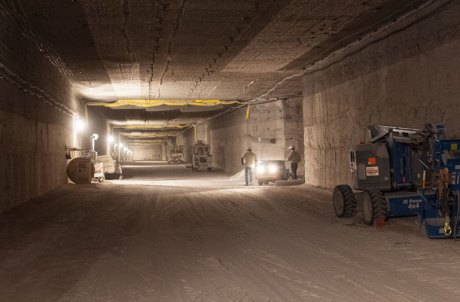More room at WIPP
05 August 2013
A new panel of seven waste disposal rooms at the world's only operating geological radwaste repository is ready and waiting to start receiving defence-related transuranic waste.
 |
| WIPP's Panel 7 is now ready for service (Image: DOE WIPP) |
Panel 7 at the US Department of Energy's (DOE's) Waste Isolation Pilot Plant (WIPP) in New Mexico has received approval from the New Mexico Environment Department, allowing it to be used to dispose of the defence-sector waste materials which are contaminated with man-made radioisotopes that are heavier than uranium.
DOE Carlsbad field office manager Joe Franco praised the "timely" approval of the new suite of rooms, which will enter use as soon as Panel 6, where waste is currently being emplaced, becomes full. "We may begin using the [new] panel in August," Franco said.
A WIPP panel consists of seven waste disposal rooms, each approximately 4 metres high, 10 metres wide and just over 90 metres long. The rooms are hewn from a geologic salt formation some 655 metres below ground. It takes between two and two-and-a-half years to mine and outfit a panel, including the installation of electricity, monitoring equipment and air regulating bulkheads, after which the panel must be certified by a professional engineer before review, inspection and approval by the New Mexico Environment Department.
WIPP, which has been in operation since 1999, accepts so-called contact-handled wastes and a small percentage of remote-handled wastes which are shipped to the facility from sites around the USA including the country's national nuclear laboratories. As of 28 July, 87,514 cubic metres of contact-handled wastes and 343 cubic metres of remote-handled wastes had been disposed in the salt formation. The waste itself typically comprises materials such as clothing, tools, rags, residues, debris, soil and other items contaminated with radioactive elements, mostly plutonium, accumulated over the lifetime of the USA's nuclear defence program.
The wastes, contained in steel containers, are placed into the salt formation and surrounded with a backfill material. The salt formation's natural properties take care of the long-term isolation of the waste: geological salt environments have a very low rate of groundwater flow, making them suitable for containing the long-lived radionuclides. The salt itself is plastic, meaning that the excavations are gradually self-sealing: at WIPP, a panel naturally begins to close at a rate of about 7.5-15 cm per year. This feature means that the waste effectively becomes permanently encapsulated in the salt formation and isolated from the biosphere.
WIPP is available only for the disposal of defence-related radioactive wastes. The country has re-embarked on the process of developing a strategy to manage non-military high-level wastes, including used reactor fuel, after plans for a permanent geologic repository at Yucca Mountain in Nevada were effectively shelved by the US administration.
Researched and written
by World Nuclear News